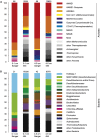Microbial Communities in Methane- and Short Chain Alkane-Rich Hydrothermal Sediments of Guaymas Basin
- PMID: 26858698
- PMCID: PMC4731509
- DOI: 10.3389/fmicb.2016.00017
Microbial Communities in Methane- and Short Chain Alkane-Rich Hydrothermal Sediments of Guaymas Basin
Abstract
The hydrothermal sediments of Guaymas Basin, an active spreading center in the Gulf of California (Mexico), are rich in porewater methane, short-chain alkanes, sulfate and sulfide, and provide a model system to explore habitat preferences of microorganisms, including sulfate-dependent, methane- and short chain alkane-oxidizing microbial communities. In this study, hot sediments (above 60°C) covered with sulfur-oxidizing microbial mats surrounding a hydrothermal mound (termed "Mat Mound") were characterized by porewater geochemistry of methane, C2-C6 short-chain alkanes, sulfate, sulfide, sulfate reduction rate measurements, in situ temperature gradients, bacterial and archaeal 16S rRNA gene clone libraries and V6 tag pyrosequencing. The most abundantly detected groups in the Mat mound sediments include anaerobic methane-oxidizing archaea of the ANME-1 lineage and its sister clade ANME-1Guaymas, the uncultured bacterial groups SEEP-SRB2 within the Deltaproteobacteria and the separately branching HotSeep-1 Group; these uncultured bacteria are candidates for sulfate-reducing alkane oxidation and for sulfate-reducing syntrophy with ANME archaea. The archaeal dataset indicates distinct habitat preferences for ANME-1, ANME-1-Guaymas, and ANME-2 archaea in Guaymas Basin hydrothermal sediments. The bacterial groups SEEP-SRB2 and HotSeep-1 co-occur with ANME-1 and ANME-1Guaymas in hydrothermally active sediments underneath microbial mats in Guaymas Basin. We propose the working hypothesis that this mixed bacterial and archaeal community catalyzes the oxidation of both methane and short-chain alkanes, and constitutes a microbial community signature that is characteristic for hydrothermal and/or cold seep sediments containing both substrates.
Keywords: ANME; Guaymas Basin; alkanes; hydrothermal vents; methane; sediment.
Figures







Similar articles
-
Microbial diversity of hydrothermal sediments in the Guaymas Basin: evidence for anaerobic methanotrophic communities.Appl Environ Microbiol. 2002 Apr;68(4):1994-2007. doi: 10.1128/AEM.68.4.1994-2007.2002. Appl Environ Microbiol. 2002. PMID: 11916723 Free PMC article.
-
Anaerobic oxidation of methane at different temperature regimes in Guaymas Basin hydrothermal sediments.ISME J. 2012 May;6(5):1018-31. doi: 10.1038/ismej.2011.164. Epub 2011 Nov 17. ISME J. 2012. PMID: 22094346 Free PMC article.
-
Diverse anaerobic methane- and multi-carbon alkane-metabolizing archaea coexist and show activity in Guaymas Basin hydrothermal sediment.Environ Microbiol. 2019 Apr;21(4):1344-1355. doi: 10.1111/1462-2920.14568. Epub 2019 Mar 18. Environ Microbiol. 2019. PMID: 30790413
-
Physiology and Distribution of Archaeal Methanotrophs That Couple Anaerobic Oxidation of Methane with Sulfate Reduction.Microbiol Mol Biol Rev. 2019 Jul 31;83(3):e00074-18. doi: 10.1128/MMBR.00074-18. Print 2019 Aug 21. Microbiol Mol Biol Rev. 2019. PMID: 31366606 Free PMC article. Review.
-
Genomic Insights into Niche Partitioning across Sediment Depth among Anaerobic Methane-Oxidizing Archaea in Global Methane Seeps.mSystems. 2023 Apr 27;8(2):e0117922. doi: 10.1128/msystems.01179-22. Epub 2023 Mar 16. mSystems. 2023. PMID: 36927099 Free PMC article. Review.
Cited by
-
Transient exposure to oxygen or nitrate reveals ecophysiology of fermentative and sulfate-reducing benthic microbial populations.Environ Microbiol. 2017 Dec;19(12):4866-4881. doi: 10.1111/1462-2920.13895. Epub 2017 Sep 15. Environ Microbiol. 2017. PMID: 28836729 Free PMC article.
-
Phylogenetic and functional diverse ANME-1 thrive in Arctic hydrothermal vents.FEMS Microbiol Ecol. 2022 Oct 17;98(11):fiac117. doi: 10.1093/femsec/fiac117. FEMS Microbiol Ecol. 2022. PMID: 36190327 Free PMC article.
-
Microbial Hydrocarbon Degradation in Guaymas Basin-Exploring the Roles and Potential Interactions of Fungi and Sulfate-Reducing Bacteria.Front Microbiol. 2022 Mar 9;13:831828. doi: 10.3389/fmicb.2022.831828. eCollection 2022. Front Microbiol. 2022. PMID: 35356530 Free PMC article.
-
Shedding light on the composition of extreme microbial dark matter: alternative approaches for culturing extremophiles.Front Microbiol. 2023 Jun 2;14:1167718. doi: 10.3389/fmicb.2023.1167718. eCollection 2023. Front Microbiol. 2023. PMID: 37333658 Free PMC article. Review.
-
Deep-branching ANME-1c archaea grow at the upper temperature limit of anaerobic oxidation of methane.Front Microbiol. 2022 Sep 23;13:988871. doi: 10.3389/fmicb.2022.988871. eCollection 2022. Front Microbiol. 2022. PMID: 36212815 Free PMC article.
References
-
- Ashelford K. E., Chuzhanova N. A., Fry J. C., Jones A. J., Weightman A. J. (2005). At least 1 in 20 16S rRNA sequence records currently held in public repositories is estimated to contain substantial anomalies. Appl. Environ. Microbiol. 71 7724–7736. 10.1128/AEM.71.12.7724-7736.2005 - DOI - PMC - PubMed
-
- Bazylinski D. A., Farrington J. W., Jannasch H. W. (1988). Hydrocarbons in surface sediments from a Guaymas Basin hydrothermal vent site. Org. Geochem. 12 547–558. 10.1016/0146-6380(88)90146-5 - DOI
Grants and funding
LinkOut - more resources
Full Text Sources
Other Literature Sources
Molecular Biology Databases
Miscellaneous

